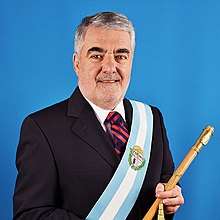Mario das Neves
Mario das Neves (April 27, 1951 – October 31, 2017) was an Argentine Justicialist Party politician. He was the governor of the Argentine province of Chubut.
Mario das Neves | |
|---|---|
 | |
| Governor of Chubut Province | |
| In office December 10, 2015 – October 31, 2017 | |
| Preceded by | Martín Buzzi |
| Succeeded by | Mariano Arcioni |
| Governor of Chubut Province | |
| In office December 10, 2003 – December 10, 2011 | |
| Preceded by | José Luis Lizurume |
| Succeeded by | Martín Buzzi |
| Personal details | |
| Born | April 27, 1951 Avellaneda, Buenos Aires, Argentina |
| Died | October 31, 2017 (aged 66) Rawson, Chubut, Argentina |
| Political party | Justicialist Party |
| Spouse(s) | Raquel di Perna |
Biography
Das Neves was born in Avellaneda (Greater Buenos Aires), to Portuguese parents, and grew up in Santa Fe. He enrolled in Law School, but left after completing 80% of his course load and moved to Chubut at the age of 20 to try out as a footballer for Huracán de Trelew, though without success. Das Neves married the former Raquel Di Perna, and has two children. He became active in the youth wing of the Peronist Justicialist Party, and by 1987 he had a key role in the administration of Trelew's municipality, under Néstor Perl.[1]
Das Neves was candidate for Mayor of Trelew in 1991 and won the first round, but lost in the second. The following year he became leader of the Chubut Justicialist Party and was elected to the Argentine Chamber of Deputies for Chubut in 1995. From his election he actively campaigned against corruption in the customs operation of Buenos Aires and headed an investigating commission that led to prosecutions. He was named "Best Deputy" in 1997. Das Neves was re-elected as a Deputy in 1999 and was the first chair of the consumer protection committee.[1]
The interim President Adolfo Rodríguez Saá appointed Das Neves Director of Customs at the end of 2001, and he consequently resigned his seat in Congress; when a few days later Eduardo Duhalde became President, he retained Das Neves as Director of Customs. He clashed with Economy Minister Roberto Lavagna, however, and resigned.[1]
Das Neves stood to be Governor of Chubut in November 2003 against the UCR incumbent, José Luis Lizurume. Das Neves won the support of fellow Peronist, newly elected President Néstor Kirchner, although Kirchner and Lizurume had been close; Das Neves won by 45.6% to 41.3%. His cordial relations with Kirchnerism soured by 2009, however, and Das Neves publicly stated that Kirchner had become "arrogant" and partisan to "dividing and conquering" by way of retaining control over Peronism, adding that, despite the former president's professed support, Kirchner was "not my friend".[2] Das Neves later initiated the privatization of a network of provincially owned public services cooperatives.[3]
Governor Das Neves was termed out of office in 2011, and he publicly considered endorsing his wife, Raquel di Perna, or his sister-in-law, Senator Graciela di Perna, as his successor.[4] He ultimately endorsed the Mayor of Comodoro Rivadavia, Martín Buzzi, and his Modelo Chubut ticket, . The elections, held on March 20, were too close to call between Buzzi and the Mayor of Puerto Madryn, Carlos Eliceche (Front for Victory). Buzzi's slim margin of victory led to a recount and a judicial injunction against results in six precincts.[5] Following a protracted recount process, as well a court-ordered re-vote held on May 29 in the six impugned precincts, Buzzi was officially elected Governor of Chubut.[6]
Das Neves unsuccessfully sought the Federal Peronist nomination for the Presidency in 2011.[7] He was later nominated by Popular Union candidate Eduardo Duhalde as his running mate.[8]
References
- "Gobernador Sr. Mario Das Neves". Provincia de Chubut. Archived from the original on 2011-06-14.
- "Das Neves: Kirchner tuvo una actitud prepotente y no es mi amigo". InfoBae.
- "El gobierno puso en marcha el proceso de privatización de las cooperativas". El Diario de Madryn.
- "Das Neves no descarta que su esposa o su cuñada puedan sucederlo". InfoChubut. Archived from the original on 2011-10-04.
- "Chubut: gana el Peronismo Federal pero el kirchnerismo no acepta la derrota". Clarín.
- "Y 69 días más tarde se eligió gobernador". Página/12.
- "Los candidatos opositores que se bajaron de la carrera presidencial". Perfil.
- "Eduardo Duhalde officially launches presidential campaign". Buenos Aires Herald.
External links
![]()
- Profile, La Nación, 2003-11-10
- 'Das Neves celebrates his triumph in Chubut', La Nación, 2003-11-10
- Profile at Chubut government
| Preceded by José Luis Lizurume |
Governor of Chubut 2003—2011 |
Succeeded by Martín Buzzi |
| Preceded by Martín Buzzi |
Governor of Chubut 2015–2017 |
Succeeded by Mariano Arcioni |